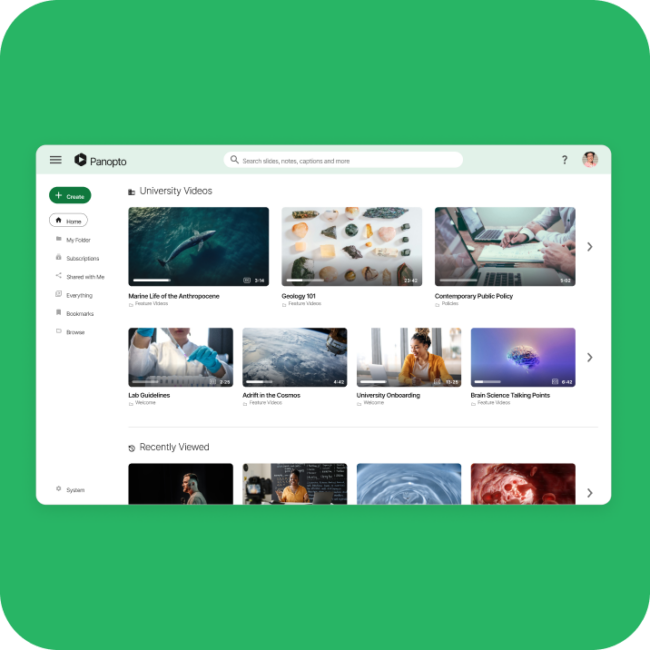- 학술 기술
일상 과제를 위한 학생 프레젠테이션 확대

태초부터 글쓰기는 학문 활동의 주요 방식이었던 것 같습니다. 학생들은 어릴 때부터 글쓰기를 통해 이해를 증명하고, 주장을 펼치며, 심지어 스스로 새로운 지식을 창출하는 방법을 배웁니다. 그리고 그것은 당연한 일이었습니다. 서면 커뮤니케이션은 쉽게 작성할 수 있고 휴대성이 뛰어납니다. 오늘날에도 수만 개의 단어가 포함된 수십 페이지를 텍스트 문서로 쉽게 캡처하여 이메일로 전송하는 것은 전혀 어렵지 않습니다.
 그러나 오늘날의 바쁜 비즈니스 세계에서 '종이'는 점점 더 밋밋하게 느껴지고 있습니다. 서면 커뮤니케이션, 특히 이메일은 여전히 중요한 커뮤니케이션 도구이지만, 이제 전문가들은 동료나 고객 모두 긴 형식의 콘텐츠를 읽고 싶어하지 않는다는 사실을 점점 더 많이 깨닫고 있습니다.
그러나 오늘날의 바쁜 비즈니스 세계에서 '종이'는 점점 더 밋밋하게 느껴지고 있습니다. 서면 커뮤니케이션, 특히 이메일은 여전히 중요한 커뮤니케이션 도구이지만, 이제 전문가들은 동료나 고객 모두 긴 형식의 콘텐츠를 읽고 싶어하지 않는다는 사실을 점점 더 많이 깨닫고 있습니다.
학교는 학생들이 직업 세계에 대비할 수 있도록 준비시켜야 한다는 의무감에 주목하고 있으며, 학생들의 실질적인 커뮤니케이션 기술을 연마할 수 있는 새롭고 더 나은 방법에 대해 고민하고 있습니다.
이에 따라 전통적인 커뮤니케이션의 또 다른 형태인 프레젠테이션이 새롭게 주목받고 있습니다. 안타깝게도 수업에 참여하는 모든 학생에게 발표할 시간을 충분히 주기 위해서는 많은 시간이 필요하기 때문에 전통적으로 수업 중 발표는 학기말 과제로 남겨져 있습니다. 결국, 줄어드는 리소스를 보완하기 위해 수업 규모가 커지는 환경에서는 학생이 수업에 추가될 때마다 총 발표 시간도 그에 따라 늘어납니다. 15명으로 구성된 학급의 모든 학생에게 10분의 발표 시간이 주어진다면, 수업 중 발표 과제 하나에 2시간 30분이 필요하다는 뜻입니다. 그렇다면 동료의 피드백과 질문을 받을 수 있는 시간은 언제인가요?
진입 장벽이 빠르게 낮아지면서 비디오는 학생 프레젠테이션의 문제를 해결할 수 있는 해결책으로 떠오르고 있습니다. 학생을 그룹으로 나누고 모든 프레젠테이션을 학급의 모든 학생이 시청할 필요가 없도록 함으로써 교수자는 비디오를 사용하여 학생들이 사용 가능한 수업 시간 내에 동료들과 함께 발표하고 복습할 수 있는 기회를 제공할 수 있습니다.
이 접근 방식은 수업 시간에 대한 부담이 적기 때문에 교수자가 프레젠테이션을 정기적이고 가치 있는 과제 유형으로 만들 수 있습니다.
학생 비디오 프레젠테이션을 통한 커뮤니케이션 기술 교육
1. 성공적인 비디오 프레젠테이션에 대한 기대치 설정
모든 과제와 마찬가지로 가장 중요한 첫 번째 단계는 기대치를 설정하는 것입니다. 과제 형식이 익숙하지 않은 경우 특히 그렇습니다.
학생에게 프레젠테이션을 제대로 하기 위해 필요한 만큼의 테이크를 녹화하는 것이 옳고 적절하다는 점을 확실히 알려주세요. 반복을 통해 학생들은 말하기와 발표에 자신감을 가질 수 있습니다.
또한 학생들과 주어진 과제에서 기대되는 '생산 가치'의 수준에 대해 이야기해야 합니다. 명확하고 간결한 전달에 중점을 두는 주간 프레젠테이션의 경우 학생이 책상에 앉아 웹캠에 대고 말하도록 하는 것이 적절할 수 있습니다. 보다 공식적인 프레젠테이션의 경우, 학생들은 스터디룸을 사용하고 공식적인 대면 프레젠테이션과 같은 복장을 갖춰야 할 수도 있습니다.
어떤 방식을 선택하든 기대치를 설정하면 학생들이 추측을 피하고 자신감을 갖는 데 도움이 됩니다.
2. 학생들에게 비디오 녹화 및 업로드 기능 제공
노트북이나 휴대폰에서 비디오를 녹화하는 것이 그 어느 때보다 쉬워졌습니다. 대부분의 스마트폰에는 동영상 캡처용 카메라와 소프트웨어가 내장되어 있습니다.
학교에서 Panopto와 같은 비디오 강의 캡처 솔루션을 사용하는 경우 동일한 시스템을 학생 기록 캡처에 활용할 수도 있습니다. 강의 및 프레젠테이션 녹화 소프트웨어는 일반적으로 YouTube에 녹화하는 것보다 더 많은 기능을 제공합니다. 특히 Panopto와 같은 도구가 PowerPoint 또는 Keynote 프레젠테이션을 직접 기록 할 수있는 기능은 학생들이 슬라이드를 비디오로 편집하거나 카메라에서 슬라이드를 읽을 수 없게 만들 필요가 없음을 의미합니다.
학생이 프레젠테이션을 녹화 한 후에는 강사와 다른 학생이 비디오에 액세스 할 수 있어야합니다. Google Classroom과 같은 클라우드 기반 파일 공유 서비스 또는 Panopto와 같은 전용 비디오 콘텐츠 관리 시스템 (비디오 CMS)에 파일을 업로드 할 수 있습니다. 비디오 CMS를 사용하면 강사가 모든 비디오 파일 을 관리하고 정확한 사람들과 정확하게 공유 할 수있는 쉽고 중앙 집중식 방법을 제공하므로 종종 선호됩니다.
어떤 방식이든 필요할 때 파일을 찾고, 공유하고, 보호할 수 있는 것이 중요합니다.
학생 프레젠테이션은 학생에게 배운 내용을 시연하도록 요청하는 효과적인 방법입니다. 이 외국어 수업용 동영상에서는 한 학생이 스페인어로 멕시코 음식에 대한 짧은 프레젠테이션을 진행합니다.
3. 수업 시간 외에 학생들이 프레젠테이션을 준비하고 녹화하게 하기
이제 재미있는 부분이 시작됩니다. 학생들이 프레젠테이션을 준비하고 녹화합니다. 모든 학생이 수업에 참석하기 위해 귀중한 수업 시간을 할애하는 대신 숙제로 프레젠테이션을 제출하면 학생들은 거의 무제한으로 프레젠테이션을 제대로 준비할 수 있습니다. 발표에 익숙하지 않은 학생은 녹화본을 검토하고 메시지를 더 잘 전달할 수 있도록 미세한 조정을 할 수 있습니다.
비디오 프레젠테이션 과제에 대한 기대치를 설정할 때는 학생이 마감일을 알고 있는지 확인합니다. 다른 학생들은 수업 시간에 프레젠테이션을 복습해야 하므로 수업 시간에 맞춰서(수업 전) 할 수 있나요, 아니면 수업 전에 영상을 수집하고 복습할 시간이 필요한가요?
4. 소그룹 수업 시간을 사용하여 동료 발표를 검토하고 피드백을 제공하세요.
학생들이 수업에 도착할 때까지 프레젠테이션이 완료되어 수업 웹사이트에 업로드되어 있어야 합니다.
이제 학생들을 학급에 적합한 규모의 그룹으로 나눕니다. 소규모 그룹은 집중적인 대화와 개별적인 동료 피드백에 더 많은 시간을 할애할 수 있는 반면, 대규모 그룹은 때때로 더 많은 아이디어를 창출할 수 있습니다.
학생들은 각 비디오를 함께 시청하고 토론하면서 콘텐츠와 전달 방식에 대한 피드백을 제공해야 합니다.
또는 학생에게 자신의 프레젠테이션을 준비하고 다른 사람의 프레젠테이션을 검토할 충분한 시간이 주어진다면 수업 전에 프레젠테이션 시청을 숙제로 내줄 수도 있습니다. 이 시나리오에서 학생들은 같은 반 친구의 프레젠테이션을 보고, 메모를 하고, 피드백에 대해 비판적으로 생각할 수 있습니다.
교육용 비디오 플랫폼에서는 비디오 플레이어 내에서 바로 타임스탬프가 찍힌 메모를 통해 학생들이 생각을 정리할 수 있으며, 비디오 작성자에게 또 다른 피드백 소스로 제공할 수도 있습니다.
5. 교수자 또는 조교가 평가를 위해 프레젠테이션을 검토합니다.
프레젠테이션을 채점하는 것이 Panopto 중요한 경우 교수자는 같은 중앙 비디오 콘텐츠 관리 플랫폼을 사용하여 평가 프로세스를 관리할 수도 있습니다. 교수자는 인기 있는 학습 관리 시스템에 통합된 의 안전한 학생용 드롭박스를 사용하여 Panopto학생의 비디오에 쉽게 접근할 수 있도록 할 수 있습니다.
비디오가 비디오 컨텐츠 관리 시스템에 업로드되면 교수자 및 조교는 Panopto 을 사용하여 학생의 비디오에 주석을 달아 피드백을 제공할 수 있습니다.
다른 방법으로 교수자는 한 걸음 더 나아가 책상에서 바로 피드백을 짧은 비디오로 녹화하여 수업 중 프레젠테이션 형식을 재현할 수도 있습니다. 이렇게 하면 학생들은 동료들과 집중적으로 토론할 수 있을 뿐만 아니라 교사로부터도 도움을 받을 수 있습니다.
학생들에게 의사 소통에 대한 자신감 제공
![]() 프레젠테이션 기술은 그 어느 때보다 중요하며, 강사는 녹화된 비디오를 통해 학생들에게 더욱 자신감 있는 발표자가 될 수 있는 기회를 제공할 수 있습니다. 학생 프레젠테이션을 정기적인 과제 유형으로 만들고 동료 및 교수자의 피드백을 정기적으로 받음으로써 학생은 더 편안함을 느낄 수 있을 뿐만 아니라 자신의 진행 상황을 비판적으로 평가할 수 있습니다.
프레젠테이션 기술은 그 어느 때보다 중요하며, 강사는 녹화된 비디오를 통해 학생들에게 더욱 자신감 있는 발표자가 될 수 있는 기회를 제공할 수 있습니다. 학생 프레젠테이션을 정기적인 과제 유형으로 만들고 동료 및 교수자의 피드백을 정기적으로 받음으로써 학생은 더 편안함을 느낄 수 있을 뿐만 아니라 자신의 진행 상황을 비판적으로 평가할 수 있습니다.
Panopto는 대학에서 강사의 프레젠테이션을 캡처하기 위해 시작되어 현재 전 세계 수만 명의 학생과 교수들이 매주 사용하고 있습니다. Windows, Mac, iOS 또는 Android 기기에서 다운로드할 수 있는 녹화 소프트웨어로, 누구나 노트북이나 스마트폰에서 비디오를 녹화하고 업계 최고의 비디오 콘텐츠 관리 시스템( Panopto)을 사용하여 수업 웹사이트에 자동으로 업로드할 수 있습니다.
학생들이 더 성공적인 발표자가 될 수 있도록 Panopto가 어떤 도움을 줄 수 있는지 알아보려면 지금 바로 팀원에게 연락하여 무료 평가판을 요청하세요.




